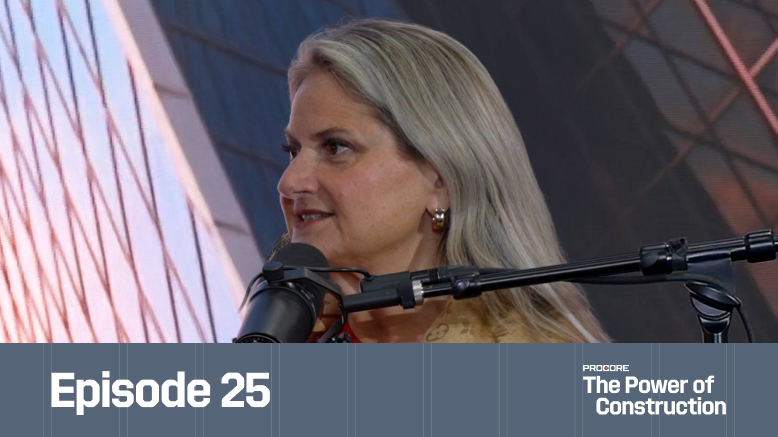— 8 min read
Optimizing Resource Use with Project Management Software


Last Updated Sep 23, 2025

Jacob Kunken
Solutions Engineer, Heavy Civil
28 articles
Jake Kunken currently works as Solutions Engineer for Procore's Heavy Civil division. He brings 14 years of experience working in various construction roles in New York and Colorado, including laborer, assistant carpenter, carpenter, assistant superintendent, superintendent, construction manager, safety manager, and project manager. Jake also spent time in EHS as an environmental engineer for Skanska. He’s worked on more than 40 commercial projects from ground-up, to heavy civil, hospital work, and tenant improvement. Jake studied Ecological Technology Design at the University of Maryland.

Kacie Goff
Contributing Writer
91 articles
Kacie Goff is a construction writer who grew up in a construction family — her dad owned a concrete company. Over the last decade, she’s blended that experience with her writing expertise to create content for the Construction Progress Coalition, Newsweek, CNET, and others. She founded and runs her own agency, Jot Content, from her home in Ventura, California.
Last Updated Sep 23, 2025

Projects, regardless of scale, end up burning money and schedule when the necessary resources aren’t ready. That’s true whether the project is short on labor, materials or equipment. To keep projects equipped with what they need, general contractors (GCs) have deployed a range of resource management strategies. GC firms often dedicate resources to managing their resources, too. That might include project management software.
Investing money in a software solution can help with resource optimization — particularly when done well. That means taking the time to appropriately train teams on how to leverage that software.
Table of contents
How Resource Issues Directly Impact Project Outcomes
When the right resources aren’t available at the right time, it negatively affects all projects in a few distinct categories.
1. Money
First and foremost, bad resource management drives up project costs. As a result, managing resources well is key to defending — and, ideally, improving — the margin.
Take a crane as an example. If the GC has to rent the crane, they have a daily burn rate associated with this piece of equipment. If that equipment sits idle due to poor planning, there’s not only a cost attached to having that equipment sit on site. There’s also an opportunity cost to not being able to deploy that equipment elsewhere. Bad planning means spending more.
Even if the GC owns the crane, it has to be taken off another jobsite and brought to this project. If managing this resource isn’t optimized, one jobsite might experience delays while waiting for the crane to be delivered once another project is done with it.
Equipment isn’t the only resource category where money gets spent when planning is poor. Materials get more expensive when they need to be rushed to the jobsite or the incorrect quantities are procured, and labor costs add up when teams aren’t allocated as efficiently as possible.
2. Relationships
In the same way that every GC needs to protect its margins, it also needs to protect its relationships. If their projects are continually disorganized, subcontractors will take note. If subs can’t rely on the GC for accurate timing, their desire to provide high-quality work decreases.
Money’s a driver in this sphere, too. Specialty contractors prioritize the companies with whom they can make the most money. Ideally, they show up to a jobsite that’s ready for their team to jump straight in, do clean work and get quickly freed up for another job.
All too often, though, subcontractors show up to a jobsite and find the opposite. The GC might even ask them to find busywork to keep their crew engaged while they wait.
When resources aren’t efficiently managed, it decreases the workload teams can handle. That breeds frustration and damages relationships. Over time, this can make it harder for the GC to find the subs they need.
3. Efficiency
Ineffective resource management makes for inefficient projects. Not having resources ready can introduce delays — and downtime for crews as they wait. That could add overtime costs in a rush to catch up once equipment or materials are ready.
Teams might try to do work out of sequence in an effort to work around a resource shortage. Often, though, that diminishes the quality of the finished product and creates negative downstream effects for the other contractors on the project.
On top of all of this, the inefficiency — and then the required rush to play catch-up — adds stress for individual workers. Construction is already a high-stress industry, and this added burden can further diminish productivity and quality.
Free AI in Construction Course with Hugh Seaton
Start learning today with industry expert Hugh Seaton and discover how AI can boost efficiency, reduce risk, and transform your projects.

What Project Management Software Can Do for Resource Usage
To protect money, relationships and jobsite efficiency, GCs need to work to optimize their resource usage. Project management software helps here in some specific ways.
Better Resource Allocation
Achieving just-in-time delivery means allocating resources well. That means teams have the right people, equipment and materials on the right job at the right time. Project management software helps GCs do this — and not just on individual projects, but across every job they’ve been awarded and accepted.
Specifically, software delivers visibility. It can help GCs plan years into the future, pinpointing which resources need to be allocated to which jobs at which times.
They might see, for example, that they’ll need a scissor lift for several projects, and that buying one will be more cost-effective than renting one multiple times. They might determine that union or non-union labor will be best suited to upcoming projects, or that a hiring sprint will be necessary in a particular busy season.
The zoomed-out visibility that a project management software delivers supports strong resource allocation. It also helps on a granular level, too. Some software can integrate with vendors’ and suppliers’ databases, for example, to quickly see what’s in stock and check lead times. This way, the GC can pivot decision-making about allocation based on what resources are actually available.
Better Planning for Lower Resource Costs
Usually, the earlier a resource can be procured and the higher volume that gets ordered, the more the cost comes down.
If a project requires 10,000 of a certain material, buying it all at once will usually be more cost-effective than buying 1,000 at a time — and that’s not to mention the reduced cost of having one shipment versus several. Thorough resource planning powered by project management software allows the GC to see how much volume is needed in total. Then, the software makes it easier to plan for the storage and JIT delivery of that material to the jobsite. As benchmarks are met on the project and recorded in the software, it can push notifications to get more material to the site as needed.
The same goes for equipment. With software in play, it gets easier to track how owned equipment is getting used — and the maintenance needs of that equipment. And because project management software helps finesse scheduling, it can minimize the hours or days during which teams need to rent equipment.
Similarly, with stronger scheduling and proactive project management, labor gets applied as efficiently as possible. For GCs, this is particularly powerful because it allows them to strategically schedule different subcontractors based both on the overall project plan and what’s actually happened on site so far. This supports project outcomes and their relationships with those individual contractors.
Insights To Propel Better Resource Management
With a project management software in its toolbox, the GC continually generates data about its resource usage. That historical data helps the company forecast. They might see, for example, that they continually order 10% extra concrete, but could safely get away with 7%. The bigger the pour the project requires, the more those savings can add up.
Plus, the analytics coming from the software can illuminate recurring issues. Does the GC estimate one category inaccurately on project after project? Does it regularly run into the same labor issues? Identifying specific areas for improvement, then acting on them, helps the GC optimize its resource usage moving forward.
Getting Teams To Buy Into Project Management Software
Thanks to humans’ natural resistance to change paired with construction’s history of slow tech adoption, plenty of construction pros push back on using software. And sometimes, they have good reason.
The right tool for the job makes work easier. The same should be true for software. If the learning curve is overly steep — and particularly if it’s unsupported — using a project management software can be frustrating. That, in turn, makes managing resources more difficult, not less.
GCs can do a few things to help get buy-in from individual team members here.
u003cstrongu003eAdopt a “train the trainer” mentalityu003c/strongu003e.
ind people who want to use the software and use it well. Teach them how to use it, then put them in a position to train others. Having one member of each team dedicated to empowering their peers means everyone has easier access to the support they need.
u003cstrongu003eFind the low-hanging fruitu003c/strongu003e.
Trying to overhaul all of a company’s resource management processes in one go leads to overwhelm — and, oftentimes, burnout. Instead, it’s often better to identify one manageable change teams can make and start there. As employees see how that software-backed process improves their lives, it builds willingness to try and tackle additional changes.
u003cstrongu003eEvaluate software use on a per-project basis.u003c/strongu003e
Not every project necessarily needs software support. Sometimes, standing the project up in the software would require more time and effort than it would save by making resource management easier. Forcing teams to use a platform when it won’t actually benefit them bolsters resistance to the software
GCs need to show their teams that using a project management software doesn’t have to be scary or painful. Often, the anticipation of the change is worse than the change itself. And when software is used well, ease is waiting on the other side.
Construction is hard money. GCs have to earn every dollar. Using a project management software can make it easier to optimize resource usage, helping GCs protect that effort and their money, relationships and efficiency on projects.
Was this article helpful?
Thank you for your submission.
0%
0%
You voted that this article was . Was this a mistake? If so, change your vote
Scroll less, learn more about construction.
Subscribe to The Blueprint, Procore’s construction newsletter, to get content from industry experts delivered straight to your inbox.
By clicking this button, you agree to our Privacy Notice and Terms of Service.
Thank you!
You’re signed up to receive The Blueprint newsletter from Procore. You can unsubscribe at any time.
Categories:
Written by

Jacob Kunken
Solutions Engineer, Heavy Civil | Procore Technologies
28 articles
Jake Kunken currently works as Solutions Engineer for Procore's Heavy Civil division. He brings 14 years of experience working in various construction roles in New York and Colorado, including laborer, assistant carpenter, carpenter, assistant superintendent, superintendent, construction manager, safety manager, and project manager. Jake also spent time in EHS as an environmental engineer for Skanska. He’s worked on more than 40 commercial projects from ground-up, to heavy civil, hospital work, and tenant improvement. Jake studied Ecological Technology Design at the University of Maryland.
View profile
Kacie Goff
Contributing Writer | Procore Technologies
91 articles
Kacie Goff is a construction writer who grew up in a construction family — her dad owned a concrete company. Over the last decade, she’s blended that experience with her writing expertise to create content for the Construction Progress Coalition, Newsweek, CNET, and others. She founded and runs her own agency, Jot Content, from her home in Ventura, California.
View profileExplore more helpful resources

Profit from Predictability: Construction Software as a Business Strategy
For general contractors, managing complex, multi-million-dollar projects, every project phase — from planning and budgeting to on-site execution — is an opportunity to lose time and money. Construction software is...

Defending Against Financial & Legal Risks on Megaprojects
The construction industry has seen marked growth in megaprojects. Some experts classify any project over $500 million as a megaproject, while others argue that the build needs to be $1...

Unlocking Project Intelligence: Moving from Raw Data to Actionable Insights
The construction industry faces a wide range of challenges, from ongoing labor shortages to frequent cost overruns. But some the biggest hurdles all stem from unpredictability. The general contractors (GCs)...

Who is accountable for innovation in construction?
Everyone says construction needs to innovate—but no one agrees on who’s actually responsible for making it happen. Is it the owner? The builders? The tech vendor? Or is innovation everyone’s...
Free Tools
Calculators
Use our calculators to estimate the cost of construction materials for your next project.
Templates
Find a template to help you with your construction project tasks.
Material Price Tracker
Get the latest U.S. retail prices and view historical trends for common building materials.
Glossary
Explore key terms and phrases used in the industry.
